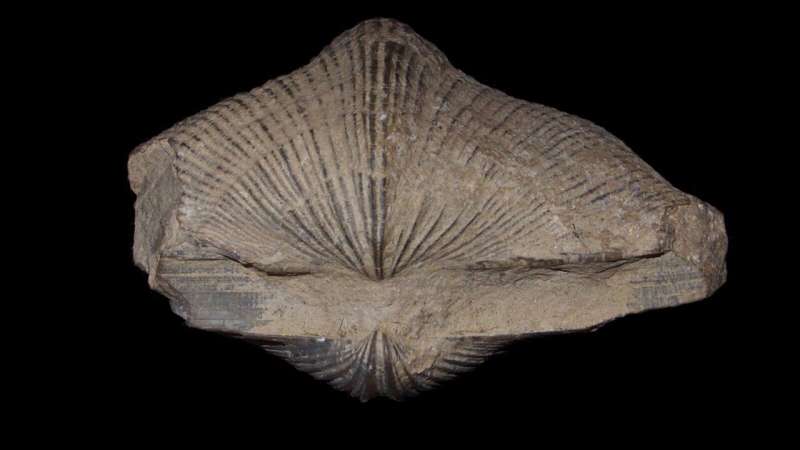This article has been reviewed according to Science X's editorial process and policies. Editors have highlighted the following attributes while ensuring the content's credibility:
fact-checked
peer-reviewed publication
trusted source
proofread
Study shows sandwich-stacked columns give brachiopod shells their strength and flexibility

Researchers have shed new light on the evolution of biomineralized columnar pillars in the shells of small marine shellfish called phosphatic-shelled or linguliform brachiopods.
The research, published today as an eLife Reviewed Preprint, is described by the editors as an important contribution to our understanding of the role and evolution of columnar shells in brachiopods, based on solid evidence.
The Cambrian, a geological period around half a billion years ago, produced the most intense burst of evolution of life in Earth's history. During this time, some marine species developed biomineralized shell architectures. In biomineralization, biologically-controlled mineralization produces organic-inorganic composite skeletons—in this case shells—that would have played a vital role in the survival and fitness of these early species.
One such species are brachiopods, which have hard shells on their upper and lower surfaces (ventral and dorsal valves). This gives them the appearance of a clam, although they are unrelated. Brachiopods emerged and spread rapidly during the Cambrian period. A subspecies, known as linguliform brachiopods, are of particular interest due to their lightweight shells with a unique combination of strength and toughness.
"These qualities are thought to be brought about by the arrangement of calcium phosphate with an organic matrix into stacked sandwiches of columnar units, which is unique to early linguliform brachiopods," explains lead author Zhiliang Zhang, a Professor at the State Key Laboratory of Palaeobiology and Stratigraphy, Nanjing Institute of Geology and Paleontology, Chinese Academy of Sciences, Nanjing, China and Macquarie University, Sydney, Australia.
"Although extensive studies have been done on living and fossil shells, most of them have focused on carbonate-shelled animals. It is therefore less understood how linguliform brachiopods evolved these columnar shells."
To gain insights into the evolution and diversity of biomineralized columns, Z.L. Zhang and colleagues examined fossils from some of the earliest families of linguliform brachiopods: Eoobolidae, Lingulellotretidae and Acrotretidae. The fossil samples were taken from the Cambrian Series 2 Shuijingtuo Formation of southern Shaanxi and western Hubei in South China—a region that is widely considered to be one of the centers for the origination and early dispersal of linguliform brachiopods.
Eoobolidae are generally considered to be the oldest known linguliform brachiopods, so the team started by examining their shells in detail. They found that the microscopic columns were stacked on top of each other to form the secondary layer of the shell, in a 'stacked sandwich model.' This sandwich architecture increases the shell's toughness, flexibility and ability to resist cracks by filling the space in between the columns with organic material—resembling the columns and reinforced concrete often used in the construction of buildings.
The authors say this efficient and economic shell structure may be responsible for the widespread dispersal of linguliform brachiopods during the Cambrian explosion.
The columns in early Eoobolidae were found to be relatively small, and the secondary layer of their shells was poorly developed, comprising just two to three sandwich units. This results in a shell thickness of around 30 micrometers. In later Eoobolidae, the number of sandwich units increased to as many as 10, resulting in a shell thickness of around 50 micrometers, but the size of the columns themselves remained the same.
Compared with Eoobolidae, the Lingulellotretidae had a more developed shell structure. The columns were larger, and the team observed up to 20 sandwich units. This resulted in a shell thickness of roughly 70 micrometers. This thicker shell allowed the Lingulellotretidae to grow to twice the body size of Eoobolidae.
The Acrotretidae appeared to have the most complex shell structure of all the Cambrian linguliforms studied. The column size, in terms of height and diameter, were shown to be around 10 times greater than those in Eoobolidae and Lingulellotretidae. They also had around 30 sandwich units, resulting in a much thicker shell of more than 300 micrometers.
In both Eoobolidae and Lingulellotretidae, the team noticed that the stacked columns were more developed around their bottom, ventral shell. This development raises a region of the body called the pseudointerarea above the shell floor, allowing greater space for the digestive system while also offering it some protection in Lingulellotretidae.
In Acrotretidae, this development was even more pronounced, which may have increased the height and strength of the ventral shell. The novel body plan—diminutive and plano-conical—of Acrotretida was established during the shell-growing process.
There are a few notable limitations to these findings. For example, the early record of shell structures in linguliform brachiopods is currently incomplete, according to the eLife public review. Additionally, the origin of phosphate biomineralization in brachiopods remains a larger mystery in animal evolution.
The authors say that more research is therefore needed into the shell ultrastructure of more-well preserved phosphatic-shelled brachiopod fossils, as well as older ancestry brachiopods (stem groups) to better understand the origin, evolution and function of biomineralization in these animals.
"The continuity of the columnar shell structure that we've seen paints a picture of a likely continuous evolutionary transformation between Eoobolida, Lingulellotretidae and Acrotretidae," concludes co-author Zhifei Zhang, a professor at Northwest University, Xi'an, China.
"The columnar shell with a stacked sandwich model has likely played a significant role in the evolution of linguliform brachiopods. It may account for the flourish of phosphatic-shelled Acrotretides in the latter half of the Cambrian, and the continued bloom of this brachiopod group to the Great Biodiversification Event."
More information: Zhiliang Zhang et al, Diversity and evolutionary growth of biomineralized columns in early Cambrian phosphatic-shelled brachiopods, eLife (2023). DOI: 10.7554/eLife.88855.1
Journal information: eLife
Provided by eLife

















